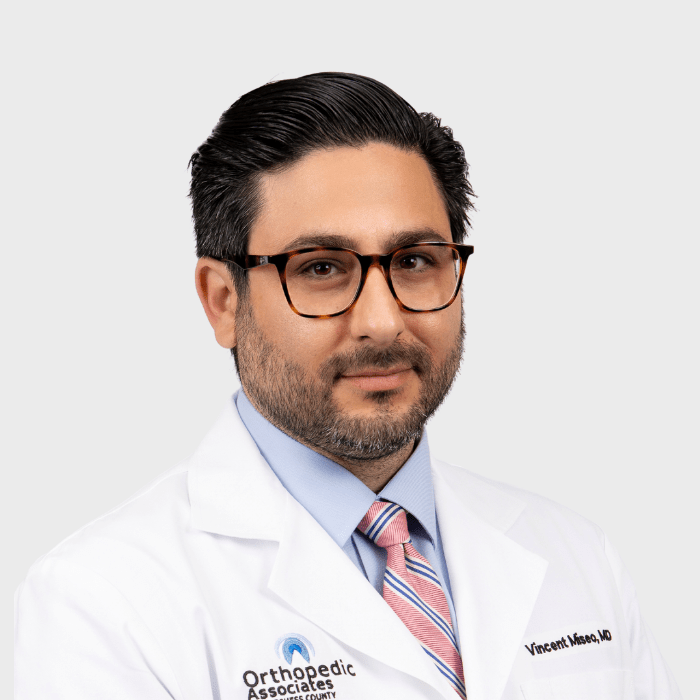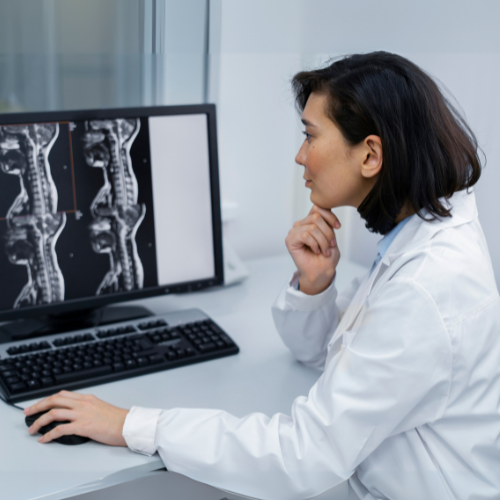
Featured Doctor
Vincent Miseo, MD
Dr. Vincent Miseo is a fellowship-trained orthopedic spine surgeon at Orthopedic Associates of Dutchess County.
View Profile

Orthopedic Spine Surgeon vs. Neurosurgeon
What’s the difference?
As an orthopedic spine surgeon, I trained in orthopedic surgery while focusing on the entire musculoskeletal system (bones, joints, ligaments and muscles). After my 5-year orthopedic residency, I completed a spine fellowship concentrating exclusively on surgical and non-surgical treatment of spine conditions. During that time, I had the opportunity to work alongside neurosurgeons, gaining a greater understanding of their approach to spine care.
Both orthopedic spine surgeons and neurosurgeons treat many of the same conditions, such as herniated discs, spinal stenosis and fractures – but we come at them from different training philosophies. In practice, the overlap is significant, and many spine surgeons today (both orthopedic and neuro) are highly specialized in spine-only care.
Degenerative vs. Congenital Conditions
How do you know the difference?
A spine surgeon will carefully take your medical history, review imaging and assess your clinical presentation to determine the root cause of your back pain.
Degenerative spine conditions typically develop over time and can be associated with aging, repetitive wear and tear or previous injuries. Examples include degenerative disc disease, spinal stenosis and facet arthritis with symptoms that gradually worsen.
Congenital spine conditions are present at birth, even if they don’t cause immediate symptoms. Examples include scoliosis, spina bifida, congenital vertebral fusion or anomalies. These are usually identifiable on X-rays or MRIs showing structural changes from fetal growth.
Nerve Pain
How can you tell what’s causing it?
My goal is to identify the exact source of nerve pain in order to treat it accurately. This involves a detailed history, physical exam, review of imaging (MRI, CT, or X-rays), and if needed, electrodiagnostic studies or diagnostic injections such as targeted nerve root blocks. Once the source is confirmed, we can create a targeted plan with medications, physical therapy, injections, and, if necessary, surgery.
Minimally Invasive vs. Open Surgery
When is each appropriate?
Whether minimally invasive (MIS) or open surgery is appropriate depends on the spinal condition, pathology extent, patient anatomy and overall health, and the goals of the procedure.
Minimally invasive surgery is best for focal issues like herniated discs or localized stenosis where we can relieve pressure or stabilize through small incisions. Benefits include faster recovery, less blood loss, and reduced muscle disruption. Common MIS procedures include lumbar discectomy, MIS decompression (laminotomy/foraminotomy), and MIS fusion techniques (TLIF, OLIF, XLIF).
Open surgery is more appropriate for complex or multi-level conditions, deformities, instability, or revision cases requiring broad exposure. Common procedures include adult spinal deformity correction, multi-level cervical/lumbar fusions, and revision surgery.
In my practice, I always prioritize the least invasive approach that achieves a complete and durable result. Sometimes, hybrid approaches—combining MIS with targeted open exposure—are the safest and most effective option. The key is tailoring the operation to each patient’s unique condition.






